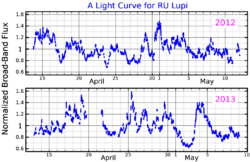Astronomy:RU Lupi
| Observation data Equinox J2000.0]] (ICRS) | |
|---|---|
| Constellation | Lupus |
| Right ascension | 15h 56m 42.31154s[2] |
| Declination | −37° 49′ 15.5021″[2] |
| Apparent magnitude (V) | 10.519[3] |
| Characteristics | |
| Spectral type | K7/M0e[4] |
| U−B color index | –0.802[3] |
| B−V color index | +0.476[3] |
| Variable type | T Tauri-type |
| Astrometry | |
| Radial velocity (Rv) | −6.4[5] km/s |
| Proper motion (μ) | RA: −10.61[2] mas/yr Dec.: −26.41[2] mas/yr |
| Parallax (π) | 6.3489 ± 0.0402[6] mas |
| Distance | 514 ± 3 ly (157.5 ± 1.0 pc) |
| Details | |
| Mass | 0.6–0.7[7] M☉ |
| Radius | 1.64[7] R☉ |
| Luminosity | 2.1[8] L☉ |
| Surface gravity (log g) | 3.9[7] cgs |
| Temperature | 3,950[9] K |
| Rotational velocity (v sin i) | 9[10] km/s |
| Age | 2–3[7] Myr |
| Other designations | |
| Database references | |
| SIMBAD | data |
RU Lupi is a star in the constellation of Lupus, located in the young Lupus Star Forming Region. Based on parallax measurements, the distance to this star is about 514 light-years (158 pc). The apparent visual magnitude is 10.5,[3] so viewing it would require a telescope with an aperture of 6 cm (2 in), but preferably larger.[11]
This is a T Tauri star, which is a stage that a newly formed, low-mass star passes through before settling down onto the main sequence, where it will generate all of its energy through hydrogen fusion at its core. The age of this star is about 2–3 million years.[7] It is showing random fluctuations in luminosity, including variations in ultraviolet and X-ray emissions.[12]
The spectrum of the star is displaying emission lines of hydrogen overlaid on the star's normal spectra.[12] This may be caused by the impact of infalling gas on the star's outer envelope, combined with the signature of a strong outflowing wind near the star.[13] Mass is accreting onto the star at the rate of about (5 ± 2) × 10−8 times the mass of the Sun per year.[7]
RU Lupi has an estimated mass of 0.6–0.7 times the mass of the Sun and 1.6 times the Sun's radius.[7] It is radiating more than double the luminosity of the Sun, at an effective temperature of about 3,950 K.[9] RU Lupi is surrounded by a circumstellar disk of dust that has a combined mass of up to 0.032 times the mass of the Sun. The particles in the disk vary in size, but range up to a centimeter in cross-section.[8]
The star exhibits periodic radial velocity variations that are attributed to stellar spots on the surface of the star, based on the correlation between the radial velocity and the bisector inverse slope (a quantity that parametrises the shape of the spectral lines). The time period of the variations makes it unlikely that they are caused by stellar pulsations as these would be expected to occur on much shorter timescales (hours rather than days), and the correlation with the bisector inverse slope makes it unlikely that an orbiting companion is responsible as reflex motion would not cause the line profile variations.[12]
References
- ↑ Siwak, Michal; Ogloza, Waldemar; Rucinski, Slavek M.; Moffat, Anthony F. J.; Matthews, Jaymie M.; Cameron, Chris; Guenther, David B.; Kuschnig, Rainer et al. (March 2016). "Stable and unstable accretion in the classical T Tauri stars IM Lup and RU Lup as observed by MOST". Monthly Notices of the Royal Astronomical Society 456 (4): 3972–3984. doi:10.1093/mnras/stv2848. Bibcode: 2016MNRAS.456.3972S. https://ui.adsabs.harvard.edu/abs/2016MNRAS.456.3972S. Retrieved 22 January 2022.
- ↑ 2.0 2.1 2.2 2.3 van Leeuwen, F. (November 2007), "Validation of the new Hipparcos reduction", Astronomy and Astrophysics 474 (2): 653–664, doi:10.1051/0004-6361:20078357, Bibcode: 2007A&A...474..653V.
- ↑ 3.0 3.1 3.2 3.3 Kilkenny, D. et al. (1985), "Optical and infrared photometry of southern early-type shell stars and pre-main-sequence variables", South African Astronomical Observatory Circular 9 (9): 55–86, Bibcode: 1985SAAOC...9...55K
- ↑ 4.0 4.1 "HD 142560 -- Variable Star of Orion Type", SIMBAD (Centre de Données astronomiques de Strasbourg), http://simbad.u-strasbg.fr/simbad/sim-id?Ident=RU+Lupi, retrieved 2012-01-12
- ↑ Wilson, Ralph Elmer (1953). "General Catalogue of Stellar Radial Velocities". Carnegie Institute Washington D.C. Publication (Washington: Carnegie Institution of Washington). Bibcode: 1953GCRV..C......0W.
- ↑ Brown, A. G. A. (2021). "Gaia Early Data Release 3: Summary of the contents and survey properties". Astronomy & Astrophysics 649: A1. doi:10.1051/0004-6361/202039657. Bibcode: 2021A&A...649A...1G. Gaia EDR3 record for this source at VizieR.
- ↑ 7.0 7.1 7.2 7.3 7.4 7.5 7.6 Herczeg, Gregory J. et al. (2005), "The Loopy Ultraviolet Line Profiles of RU Lupi: Accretion, Outflows, and Fluorescence", The Astronomical Journal 129 (6): 2777–2791, doi:10.1086/430075, Bibcode: 2005AJ....129.2777H
- ↑ 8.0 8.1 Lommen, D. et al. (March 2009), "Large grains in discs around young stars: ATCA observations of WW Chamaeleontis, RU Lupi, and CS Chamaeleontis", Astronomy and Astrophysics 495 (3): 869–879, doi:10.1051/0004-6361:200810999, Bibcode: 2009A&A...495..869L
- ↑ 9.0 9.1 Stempels, H. C.; Piskunov, N. (2002), "Spectroscopy of T Tauri stars with UVES. Observations and analysis of RU Lup", Astronomy and Astrophysics 391 (2): 595–608, doi:10.1051/0004-6361:20020814, Bibcode: 2002A&A...391..595S
- ↑ Stempels, H. C.; Gahm, G. F.; Petrov, P. P. (January 2007), "Periodic radial velocity variations in RU Lupi", Astronomy and Astrophysics 461 (1): 253–259, doi:10.1051/0004-6361:20065268, Bibcode: 2007A&A...461..253S
- ↑ Sherrod, P. Clay; Koed, Thomas L. (2003), A Complete Manual of Amateur Astronomy: Tools and Techniques for Astronomical Observations, Astronomy Series, Courier Dover Publications, p. 9, ISBN 0-486-42820-6, https://books.google.com/books?id=4zjv84hHNPcC&pg=PA9
- ↑ 12.0 12.1 12.2 Stempels, H. C.; Gahm, G. F.; Petrov, P. P. (2007). "Periodic radial velocity variations in RU Lupi". Astronomy and Astrophysics 461 (1): 253–259. doi:10.1051/0004-6361:20065268. Bibcode: 2007A&A...461..253S.
- ↑ Podio, L. et al. (March 2008), "Tracing the origins of permitted emission lines in RU Lupi down to AU scales", Astronomy and Astrophysics 480 (2): 421–430, doi:10.1051/0004-6361:20078694, Bibcode: 2008A&A...480..421P
 |


